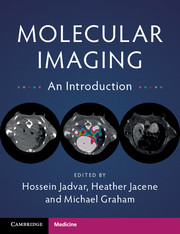Book contents
- Frontmatter
- Contents
- List of Contributors
- Preface
- 1 Instrumentation – CT
- 2 MRI/ MRS Instrumentation and Physics
- 3 Optical and Ultrasound Imaging
- 4 Instrumentation-Nuclear Medicine and PET
- 5 Quantitation-Nuclear Medicine
- 6 Perfusion
- 7 Metabolism
- 8 Cellular Proliferation
- 9 Hypoxia
- 10 Receptor Imaging
- 11 Apoptosis
- 12 Angiogenesis
- 13 Reporter Genes
- 14 Stem Cell Tracking
- 15 Amyloid Imaging
- Index
- References
15 - Amyloid Imaging
Published online by Cambridge University Press: 22 November 2017
- Frontmatter
- Contents
- List of Contributors
- Preface
- 1 Instrumentation – CT
- 2 MRI/ MRS Instrumentation and Physics
- 3 Optical and Ultrasound Imaging
- 4 Instrumentation-Nuclear Medicine and PET
- 5 Quantitation-Nuclear Medicine
- 6 Perfusion
- 7 Metabolism
- 8 Cellular Proliferation
- 9 Hypoxia
- 10 Receptor Imaging
- 11 Apoptosis
- 12 Angiogenesis
- 13 Reporter Genes
- 14 Stem Cell Tracking
- 15 Amyloid Imaging
- Index
- References
Summary
Introduction
Amyloid is protein composed of linear nonbranching fibrils arranged in sheets. Amyloidosis is a disease characterized by misfolding proteins, aggregation, and extracellular depositions of amyloid in tissue and organs. There are at least 20 described types of amyloid protein in humans which vary by precursor protein and resultant organs of deposition. Amyloid deposition may be localized (e.g. brain in Alzheimer's disease (AD)) or systemic (e.g. primary light chain amyloidosis), and there is a wide range of clinical manifestations, from none to severe organ dysfunction.
In regard to selective imaging of amyloid protein, most work thus far has been on developing agents targeting beta (β)-amyloid (Aβ) plaques in the brain, which will be the focus of this chapter. Clinical applications for amyloid imaging of the heart and systemic amyloid deposition are also emerging.
Beta Amyloid Plaques and Pathologic Basis for Alzheimer's Disease
Aβ protein is a 36–43 amino acid peptide cleaved from the transmembrane Aβ protein precursor by β and gamma (γ) sectretase (Figure 15.1). The normal function of Aβ protein is not well understood. Some described potential roles are activation of kinase enzymes, protection against oxidative stress, regulation of cholesterol transport, and serving as a transcription factor or antimicrobial. Plaques containing Aβ protein are described as diffuse or dense, with current imaging probes having affinity for the latter.
Radiopharmaceuticals for Aβ Amyloid PET Imaging
Carbon-11 Pittsburgh Complex B
Carbon-11 Pittsburgh (11C-PiB) was the first radiopharmaceutical developed for targeting Aβ plaques. 11C-PiB is derived from thioflavin T, a fluorescent dye that binds amyloid and is used to histologically identify plaques in brain tissue specimens. PET imaging is performed 40–50 minutes after tracer injection for 20–30 minutes. Normal distribution of 11C-PiB is in cerebral white matter (Figure 15.2, top row). In disease states, there is usually much less dense plaque deposition in cerebellar gray matter compared to cortical gray matter, so the cerebellum is most commonly used as a reference region. Visually, uptake of 11C-PiB in cortical gray matter at least equal to or greater than white matter is considered abnormal (Figure 15.2, bottom row). Standardized uptake value (SUV) ratios comparing cortical to cerebellar gray matter uptake may also be determined, with the upper limit of normal reported as 1.3–1.6. Correlations between 11C-PiB uptake in cortical gray matter and postmortem assessments of Aβ plaques have been demonstrated.
- Type
- Chapter
- Information
- Molecular ImagingAn Introduction, pp. 76 - 80Publisher: Cambridge University PressPrint publication year: 2017



